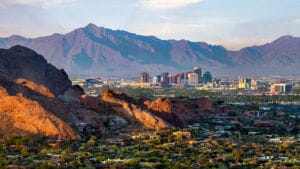Insight into innovation: GPEC leads cooperative effort to draw more ‘clean tech’ industry to Arizona
Green technology is still a relatively small part of Arizona’s economy, but its potential for growth is a bright spot on the state’s horizon.
“At a time when other economic engines have been sputtering, anticipated green job growth among Arizona’s green economy firms is quite promising,” say authors of a report prepared for state economic development officials by The Council for Community and Economic Research. It is one of two recent reports that assesses the industry and its growth potential.
While there is no standard definition of “green tech” or “clean tech,” it has been described by Clean Edge, a clean-tech research firm, as “a diverse range of products, services, and processes that harness renewable materials and energy sources, dramatically reduce the use of natural resources, and cut or eliminate emissions and wastes.” So even defining “green tech” or “clean tech” can be difficult, The Council for Community and Economic Research acknowledges.
That is why the Greater Phoenix Economic Council ( GPEC ) is embarking on a 12- to 18-month study to better define Arizona’s clean tech sector, says its president and CEO Barry Broome.
It’s a big undertaking, Broome says, but an important one given the impact that clean tech, particularly renewable energy, will likely play in driving the state’s future economy.
In fact, Broome predicts that renewable energy — particularly solar energy companies and the extensive supply chains that grow up around them, as well as companies that produce energy-efficient technologies — will become major players in Arizona in the future.
“It’s going to be our biggest industry outside of healthcare,” he says. “In 10 years, 100 percent (of homes built in Arizona) will be solarized at some level.”
That economy includes not just traditional solar manufacturers, but also materials producers — companies that make smart meters, water-use monitors and biodegradable drywall, for example.
The numbers
Overall, Arizona was home to 30,716 green jobs in 2010, about 1.3 percent of total statewide employment, according to the research report, titled “Green Jobs in Arizona 2010.”
But it says green jobs were expected to grow at a healthy 8.6 percent clip in 2011, outpacing the projected rate of 0.7 percent for all other jobs.
A second report by Battelle, a non-profit research organization, parallels the assessment that the green economy in Arizona is still emerging, but can expect strong future growth, particularly in renewable energy, greenhouse gas reduction and energy-efficiency sectors.
One key factor in this growth is a state leadership that creates a business climate that promotes innovation, the report says.
Faces behind the numbers
If you want to put a name to those numbers, turn to Greg Armstrong, chief operation officer for Rioglass Solar, a Spanish company that makes tempered glass reflectors and is the primary manufacturer for Abengoa Solar, which is building a 280-megawat solar power plant near Gila Bend.
Rioglass placed its U.S. headquarters and manufacturing operation in Surprise and plans another $45 million in capital investments.
The company was considering sites in Denver, Albuquerque and even Mexico when it visited the Surprise location, Armstrong says. The method GPEC used to draw Rioglass Solar to Arizona is a good example of what the state needs to continue to do to lure renewable energy companies, he says.
GPEC organized a meeting on site, in a tent, that brought together all the principal players in the effort: state officials, Surprise representatives, utility employees and economic development officials.
That was a first for Rioglass, Armstrong says, and an indication of what came next: Surprise waived some fees involved in the expensive process of siting the plant, invested in infrastructure upgrades and created an expedited permit package that enabled Rioglass to break ground in January and take occupancy by July.
For more information about GPEC, visit gpec.org.
Arizona Business Magazine January/February 2012




